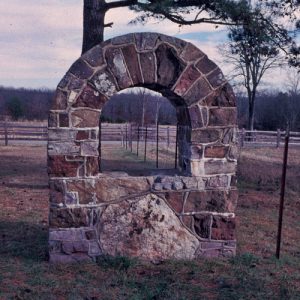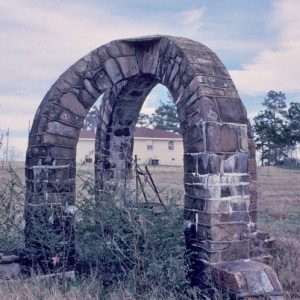calsfoundation@cals.org
Damascus CCC Camp No. 3781 Historic District
The Damascus CCC Camp Co. No. 3781 Historic District, located on Camp Hill Road in Damascus (Van Buren and Faulkner counties), is a collection of stone structures associated with a Civilian Conservation Corps (CCC) facility that operated there in cooperation with the U.S. Soil Conservation Service (USCS) during the Great Depression.
The Damascus area had long seen agricultural use, which led the CCC to establish Camp Damascus there on June 1, 1935, under USCS control to help rehabilitate farmland in a region damaged by a long history of poor farming techniques. Junior Company 3781, SCS-5 was located on a forty-acre site leased for one dollar per year from William A. Brown. Construction of the camp began on June 12, and the first barracks building was completed by July 1, with all buildings constructed by August 15.
Lieutenant William P. Havens arrived on June 23, 1935, with the first twelve residents of the camp. Other young men from Texarkana (Miller County) arrived on July 1, and Project Superintendent W. T. LaFollette took up his duties on July 25. The camp’s full complement of 200 men was reached on August 1, and the CCC troops began such farmland improvements as terracing damaged land, planting trees, and working with farmers to move from row crops to cattle farming.
In late October 1936, the camp was designated as a veterans’ camp, and the Arkansas Gazette reported that “all junior enrollees in Company 3781 at Damascus will be transferred to other camps and the vacancies filled with World War veterans.…Nearly 300 veterans will be assigned to the Damascus camp.” Some 250 veterans from around Arkansas applied for the camp, of whom 207 were selected for Company 3781-V. The 1937 CCC annual report stated: “When Company 3781 was disbanded and Company 3781-V took its place, the members of the new enrollees were taught the work being done by the Soil Conservation Service and soon proved that they could carry on and compete with any SCS Company either junior or veteran.”
As World War II loomed in 1941, enrollment in the CCC declined, and Camp Damascus was closed and its buildings sold off. Three structures remain from the CCC era at Camp Damascus: a stone 1936 entry arch emblazoned with concrete numbers and letters reading “CO-3781” and “V-CCC,” an arched stone menu board built around 1935, and a well surrounded by a four-pronged arch of stone buttresses that was completed in 1935. A 1951 ranch house constructed by noted area builder and stone mason Silas Owens Sr. stands in the center of the Damascus CCC Camp Co. No. 3781 Historic District. A copy of Sergey Kararyan’s CCC Worker sculpture was placed near the entrance gate around 2008; the same sculpture can be seen at Devil’s Den State Park and Petit Jean State Park.
The Damascus CCC Camp Co. No. 3781 Historic District was listed on the National Register of Historic Places on December 31, 2002. The remaining structures are located on private land but are visible from the road.
For additional information:
Arkansas CCC District, Seventh Corps Area. Official Annual Arkansas District Civilian Conservation Corps, Seventh Corps Area. Little Rock: Headquarters District, 1937.
“CCC Exhausts Arkansas List of Applicants.” Arkansas Gazette, October 24, 1936, p. 7.
Hope, Holly. “An Ambition to be Preferred: New Deal Recovery Efforts and Architecture in Arkansas, 1933–1943.” Little Rock, Arkansas Historic Preservation Program, 2006. Online at http://www.arkansaspreservation.com/News-and-Events/publications (accessed January 31, 2019).
———. “CCC Camp Co. #3781 Historic District.” National Register of Historic Places registration form. On file at Arkansas Historic Preservation Program, Little Rock, Arkansas. Online at http://www.arkansaspreservation.com/National-Register-Listings/PDF/VB0237.nr.pdf (accessed January 31, 2019).
Smith, Sandra Taylor. The Civilian Conservation Corps in Arkansas, 1933–1942. Little Rock: Arkansas Historic Preservation Program, 1992. Online at http://www.arkansaspreservation.com/News-and-Events/publications (accessed January 31, 2019).
Mark K. Christ
Central Arkansas Library System
 Early Twentieth Century, 1901 through 1940
Early Twentieth Century, 1901 through 1940 Historic Preservation
Historic Preservation Soil Conservation
Soil Conservation Damascus CCC Camp Menu Board
Damascus CCC Camp Menu Board  Damascus CCC Camp Arch
Damascus CCC Camp Arch  Damascus CCC Camp Well
Damascus CCC Camp Well 



Comments
No comments on this entry yet.